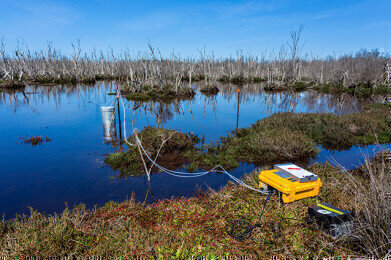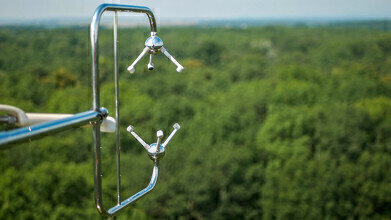-
 Monitoring GHG emissions flux from boggy land
Monitoring GHG emissions flux from boggy land -
 Eddy Covariance atmospheric gas analyser for GHG monitoring
Eddy Covariance atmospheric gas analyser for GHG monitoring
Air Monitoring
Greenhouse gas analysis in the soil, air and laboratory
Jun 16 2021
Author credit – Stephen B. Harrison and Maria James, sbh4 consulting
The Paris Agreement on climate change sets a framework for the control of greenhouse gas emissions. It has been a catalyst for many efforts related to decarbonisation. Interestingly, it does not explicitly mention carbon dioxide once. Neither does it name methane, nitrous oxide, nor fluorinated hydrocarbons, known as F-Gases, which are all potent greenhouse gases.
Legislation has also been implemented around the world to focus on the processing and use of F-Gases, such as Regulation (EU) No 517/2014. In the United States, EPA greenhouse gas emissions regulations include a focus on nitrous oxide alongside F-Gases, methane, and carbon dioxide.
Global warming caused by man-made greenhouse gas emissions is causing ecosystems to change. These changes can result in a higher level of methane emissions. For example, as the tundra in Siberia thaws, trapped methane gas is released into the atmosphere. Human activity has pushed the first domino, the next ones are beginning to topple. On a one-hundred-year basis, for an equivalent mass of gas, methane is estimated to be 30 times more harmful than CO2 as a greenhouse gas.
Soil flux methane measurement
Many types of bacteria exist that transform rotting plant material in the soil into gases and compounds. Mosses are particularly sensitive to the presence of ammonia, which is both an airborne and waterborne contaminant. Methanogenic bacteria decompose plant debris and generate methane gas, which is subsequently discharged into the atmosphere.
Over thousands of years, this process has formed peat bogs. Many of these bogs are drying out due to anthropogenic activities. When a peat bog is no longer humid, methane and carbon dioxide are emitted into the atmosphere, contributing to global warming.
Methane soil flux measurement is well suited for gas analysers. There are two common approaches to estimate methane soil flux: samples may be obtained using a syringe in the laboratory, or measurements may be made on-site to reduce the delays, expenses, and sample transit mistakes.
As an example, OF-CEAS laser technology can be used for soil flux methane monitoring. The technology uses optical feedback cavity adsorption spectroscopy and employs near-infrared light to detect greenhouse gases such as methane, carbon dioxide, and nitrous oxide at trace amounts.
For soil flux emissions measurements, a chamber is positioned suitably over the bog and the gas flux sample circulates through the Trace Gas Analyzer. The increasing gas concentration in the chamber is used to estimates the greenhouse gas emissions from a wide geographic region such as a peat bog.
Soil flux measurements require infrequent calibration since absolute concentration is not necessary, but worldwide atmospheric research methods demand daily drift tests using commercial specialty gas mixes with weekly calibration using traceable reference materials.
Some stringent experimental protocols require the gas analyser to be returned to the instrument manufacturer for an annual service. That would include calibration using the unique standards created by the Carbon Cycle Greenhouse Gases group (CCGG) of the U.S. National Oceanic and Atmosphere Administration (NOAA).
CO2 flux measurement in the atmosphere
CO2 flux measurement is essential for atmospheric research. It determines the exchange of carbon dioxide, methane, water, and perhaps other gases between the ecosystem and the atmosphere. The eddy covariance approach is now widely used to research how forests breathe.
Measuring the flux of carbon dioxide above or around the forest gives scientists insights into atmospheric conditions and clues about potential long-term changes in air composition. Typical eddy covariance equipment uses a three-dimensional anemometer to acquire wind speed and direction. A gas analyser detects variations in carbon dioxide levels.
Similar instrument configurations can be used for methane and moisture measurements to give a comprehensive view of the biosphere. The gas analyser in such instruments operates at 10 Hz, meaning that 10 gas analysis readings are obtained per second. This high frequency helps to build an accurate picture of the gas fluxes in turbulent windy conditions.
Speed is the key for eddy covariance. Wind can move air quickly with rapid changes in speed and direction. To measure the carbon dioxide gas transport flux accurately, both the wind speed and CO2 concentration must be monitored at high frequencies.
Most commonly, open-path analysers are used due to their simplicity and low power draw. However, in rainy locations, or where the atmosphere is heavily polluted with dust a closed-path gas analyser is preferred for the eddy covariance equipment.
F-Gas measurement on laboratory gas analysers
The EU F-Gas rules regulate the manufacture of fluorinated hydrocarbon gases or their recovery. Also, they stipulate which gases are allowed in particular applications. For end-users, they also mandate leak testing.
F-Gas emissions are also required in many greenhouse gas emission control systems. Some F-Gases can be quantified using a GC-ECD gas analyser. It involves gas chromatography combined with an electron capture detector (ECD) to separate the chemical species in the sample.
Scientists at the University of Bristol have been trying to discover if the top-down method of reporting F-Gas emissions is accurate. The research team at Bristol apply a pre-concentration method using their Medusa system followed by a GC-MS to measure extremely low atmospheric concentrations of F-Gases.
According to their research, they have found that a lot more F-Gas leaks exist than are being reported. The motivation to continue to implement best practices for handling refrigerant gases and continue to implement energy-efficient, low-GWP alternatives remains high.
Digital Edition
IET 34.2 March 2024
April 2024
Gas Detection - Biogas batch fermentation system for laboratory use with automatic gas analysis in real time Water/Wastewater - Upcycling sensors for sustainable nature management - Prist...
View all digital editions
Events
Apr 22 2024 Hannover, Germany
Apr 22 2024 Marrakech, Morroco
Apr 23 2024 Kuala Lumpur, Malaysia
Apr 23 2024 Kintex, South Korea
Apr 23 2024 Edmonton, AB, Canada

















